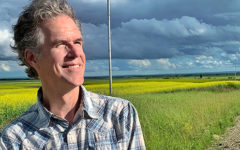 The following is an unsolicited contribution from Ted Lehmann, a regular reader of Bluegrass Today. The views expressed are his, and are not necessarily those of the authors of Bluegrass Today. Commenting is enabled for all ViewPoint posts, so please feel free to chime in with your own thoughts.
The following is an unsolicited contribution from Ted Lehmann, a regular reader of Bluegrass Today. The views expressed are his, and are not necessarily those of the authors of Bluegrass Today. Commenting is enabled for all ViewPoint posts, so please feel free to chime in with your own thoughts.
The recent announcement of Bob Dylan as a broadcaster for XM Radio, added to Howard Stern on Sirius Radio, poses a serious threat the development of bluegrass. The picture of dueling superstars on satellite radio raises red flag of increasing commercialization that can infect bluegrass at every level. Already the bluegrass programming on XM is suffering from neglect as the satellite service appears to have removed its on-air hosts in favor of running recorded programming full time. While I”ve only been listening to XM radio for six or seven months, I”ve noticed a change in their bluegrass programming. During the spring and summer, I heard live in-studio interviews with Doyle Lawson and also Mountain Heart. XM also featured album rollouts, for instance, Jamie Hartford commented on each track of his new disk of his father”s music. Such programming provided important insights into the world of bluegrass. While they still replay these programs on Saturday afternoons, there don”t appear to be new ones in the works.
Another factor affecting XM seems to be the appointment of Kyle Cantrell as program director. His on-line biography emphasizes his roots in Nashville and the Grand Ole Opry, where he served as an announcer for a number of years. There”s no evidence in the bio of a connection to bluegrass. Rather he”s a country music guy with a great voice and a noted on-air personality. Meanwhile, Felton Pruitt, who was an effective and knowledgeable on-air voice has disappeared from Bluegrass Junction, but apparently not from XM.
All this would not seem quite so ominous if it weren”t for what seems to be happening at IBMA. The move to Nashville presages a push for greater legitimacy within the world of country music. The recent IBMA awards show, at least as it sounded on XM, represented a failed attempt to sound like the typical glossy awards show. In trying to sound and look like Nashville, IBMA succeeded in appearing second rate. In the marvelous film Bluegrass Journey, the IBMA award show appeared to be a bit glossy, but was made interesting by the emphasis on jamming going on throughout the building. By contrast, I understand that jamming and access to it were limited in Nashville this year. Glitz is not the road to a broader public for bluegrass.
Our interest in bluegrass music has grown from a few brief encounters, through several years of attendance at Merlefest, to participation in the smaller and more intimate festivals in the northeast like Pickin’ in the Pasture and the Jenny Brook Family Festival. As we”ve listened to the music, met the artists, and begun playing the music ourselves, our love for bluegrass and interest in it have grown and become richer. At the same time, we have found ourselves buying gear, music, instructional recordings, and instruments. The Internet has given us access to a vast pool of information and entertainment. Our tastes have moved from an interest in country music to a passion for bluegrass. In our search for greater authenticity and intimacy, we have moved in exactly the opposite direction of where bluegrass, in it”s official, organized capacity, seems determined to take itself. I fear most of all the possible Clear Channelization of bluegrass.
Perhaps the finest manifestation of what”s best about bluegrass can be found in a small festival put on each year by Jennings Chestnut, who makes wonderful mandolins, in Conway, South Carolina. Bluegrass on the Waccamaw is a one day, “free to the public,” festival held at the Old Peanut Warehouse in Conway on the second Saturday in May each year. Somehow, by dint of good connections and very hard work, Jennings has managed to keep this festival going while attracting great bands. Last year he headlined J.D. Crowe and the New South, Ronnie Reno and the Reno Tradition, and BlueRidge while presenting a high quality group of supporting bands. In May of 2006, Bluegrass on the Waccamaw will headline Dry Branch Fire Squad and The Grascals. Last year”s crowd consisted of a lot of local folk and a sprinkling of people coming over from Myrtle Beach, about ten miles to the east.
The attendance at Bluegrass on the Waccamaw mirrors the wider audience for bluegrass. It is anchored in rural (though not necessarily southern) audiences with very strong representation from suburban and urban fans who enjoy and respect the rural roots, while adding the sophisticated appreciation of more urbane musical tastes represented by groups like Seldom Scene and Tony Trischka in a variety of manifestations. A good bluegrass festival combines these elements and appeals to a broad audience which seems to enjoy being together. If bluegrass becomes increasingly concert oriented it must alienate its fan base, which deeply appreciates the degree to which bands are accessible, venues which are friendly, and music which speaks to them. Anything else can only hurt the spread of the music.







